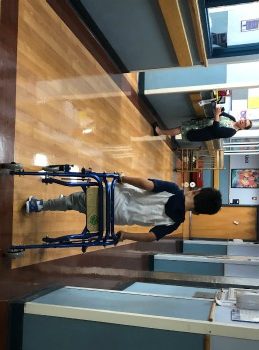By Shenandoah Robinson, M.D.
Before I began treating Mohammad Almutairi, 9, he walked with a gait typical of patients with cerebral palsy. His muscles were shorter than those of a healthy child, and his hamstrings were tighter — they pulled him up on his toes and forced his legs to cross as he tried to take a step. We call this condition “spasticity.”
Specifically, Mohammad’s condition is called spastic diaplegia, which means spasticity that only affects the legs. About one-third of kids with cerebral palsy have this condition.
Cerebral palsy arises from an injury to or abnormality of the developing brain before birth. As in many multiple pregnancies, Mohammad and his twin sister were born premature, which increases the risk of cerebral palsy.
Mohammad was very young when his family realized he had cerebral palsy — he began physical therapy at the age of three. Doctors in Kuwait told Mohammad’s parents that he would not walk without a series of intensive orthopedic surgeries over a number of years, and that those surgeries might interfere with his growth.
His parents traveled the world and even sought help at another U.S. hospital, but without luck. They were deciding how to proceed when they heard about an acquaintance’s daughter whom we treated here at Johns Hopkins. They saw her before and after surgery and started thinking about traveling to Baltimore.
Now, after several months of treatment, Mohammad’s mother says she’s glad they chose us.
Aligning Expertise
At Johns Hopkins’ Kennedy Krieger Institute, we have a unique multidisciplinary clinic that brings together experts from different specialties to evaluate patients with spasticity. Our orthopedic surgeons, rehabilitation doctors, physical therapists, neurologists and neurosurgeons all offer specialized expertise to determine the best course of treatment for our patients. Only a couple hospitals in the United States have this cohesive approach. Here, we work together very well as a team.
In Mohammad’s case, we decided there was another option — a neurosurgical procedure called selective dorsal rhizotomy. In this procedure, the surgeon removes a layer of bone in the back of the spine and then cuts certain nerve rootlets in the spinal cord to improve muscle tone and stiffness.
We’re one of a few hospitals that perform this surgery minimally invasively, reducing the risks and recovery time. Recovery time is critical for cerebral palsy patients because the longer they’re recovering with limited movement, the higher the risk of serious complications such as pneumonia.
The procedure is ideal only for certain children — those who are able to take even a few steps on their own and those who have strong body core and lower back muscles. Maybe most importantly, the patient — and the family — has to be motivated and committed to the intensive physical therapy that will follow.
It’s a huge commitment to come here from Kuwait, to uproot the family for this treatment, but Mohammad and his parents showed their dedication from the very start.
Huge Headway
Following the surgery, Mohammed has made incredible progress — better even than we anticipated. He is always eager to show me and his other clinicians just how well he’s doing. When he walks with his walker, his legs are relaxed, his gait is slow but steady. Now he can even walk short distances without the walker. His smile is always huge.
His parents say they want other families from around the world to know about the possibilities Johns Hopkins offers. They didn’t know what to expect when they came to Baltimore — but now, his mother says, they’re incredibly grateful to everyone involved in his care — to Johns Hopkins Medicine International for facilitating their care, to all the doctors, surgeons, physical therapists and nurses.
For his part, Mohammad says he looks forward to seeing his sisters back home in Kuwait, to returning to school, to playing football better than ever — and one day, to being a police officer, just like his father.
Shenandoah Robinson, M.D., is a nationally recognized expert in the treatment of epilepsy and spasticity and is a professor of neurosurgery with Johns Hopkins Medicine. Her research focuses on clarifying how early insults to the developing brain lead to deficits, such as cerebral palsy and epilepsy, and how to mitigate these deficits with neuroreparative agents. She is also a prolific researcher and award-winning teacher. She has written dozens of peer-reviewed professional journal articles and more than 15 book chapters, and she has mentored numerous pediatric neurosurgery trainees.
